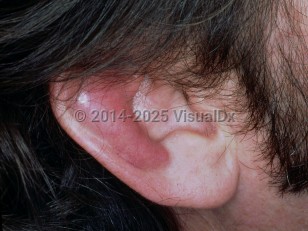Wound seroma
Alerts and Notices
Important News & Links
Synopsis

A wound seroma is an accumulation of serous fluid in the subcutaneous layer that follows a surgical procedure. Tissue damage and increased vascular permeability result in a sterile collection of proteinaceous fluid in the dead space within the tissue. It typically develops shortly after surgery, but may form a week or two later. If untreated, it can persist for many months. It may undergo secondary calcification. Smaller seromas do, however, tend to resolve spontaneously.
A seroma is usually painless, but mild discomfort may occur. A clear discharge may be present. In the rare case of secondary infection, a seroma may become tender and develop into an abscess requiring immediate medical attention. Other signs of infection include fever and a bloody, malodorous, or purulent discharge.
The most common types of surgeries that cause wound seromas are breast, abdominal wall, and reconstructive surgeries, particularly if skin flaps are created or if a foreign body, such as prosthetic mesh, is introduced.
A seroma is usually painless, but mild discomfort may occur. A clear discharge may be present. In the rare case of secondary infection, a seroma may become tender and develop into an abscess requiring immediate medical attention. Other signs of infection include fever and a bloody, malodorous, or purulent discharge.
The most common types of surgeries that cause wound seromas are breast, abdominal wall, and reconstructive surgeries, particularly if skin flaps are created or if a foreign body, such as prosthetic mesh, is introduced.
Codes
ICD10CM:
L76.34 – Postprocedural seroma of skin and subcutaneous tissue following other procedure
SNOMEDCT:
239159001 – Wound seroma
L76.34 – Postprocedural seroma of skin and subcutaneous tissue following other procedure
SNOMEDCT:
239159001 – Wound seroma
Look For
Subscription Required
Diagnostic Pearls
Subscription Required
Differential Diagnosis & Pitfalls

To perform a comparison, select diagnoses from the classic differential
Subscription Required
Best Tests
Subscription Required
Management Pearls
Subscription Required
Therapy
Subscription Required
References
Subscription Required
Last Reviewed:03/07/2017
Last Updated:03/07/2017
Last Updated:03/07/2017
Wound seroma

